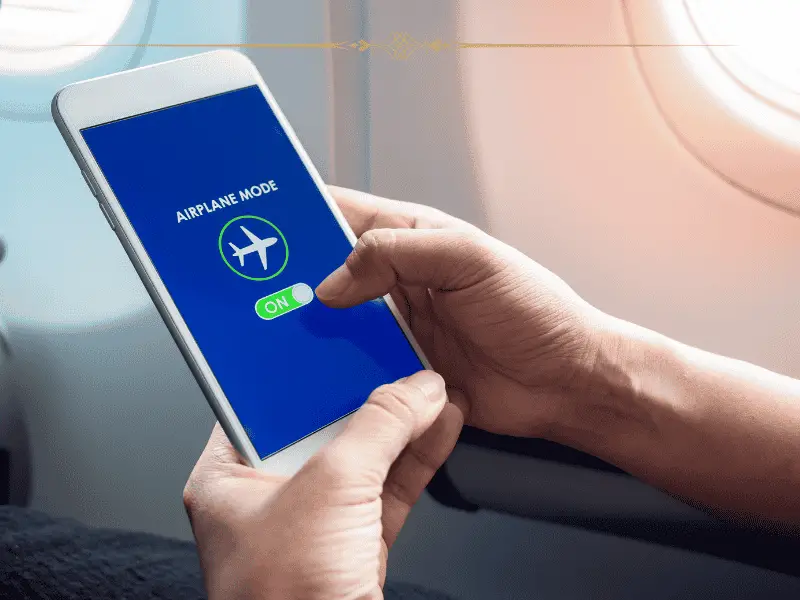When flight attendants make their pre-takeoff announcements, the instruction to switch devices to airplane mode has become as routine as fastening seatbelts. Most passengers comply without question, but few understand the real reason behind this ubiquitous air travel rule. Recently, a commercial airline pilot with military flying experience has brought clarity to this mystery, explaining that while your phone won’t cause the aircraft to plummet from the sky, it could create serious communication challenges for the flight crew.

Beyond the Myths: What Really Happens When Phones Stay Active
Contrary to dramatic scenarios depicted in movies or anxious passengers’ imaginations, an active cellular device won’t crash the plane or interfere with critical navigation systems. The reality is more nuanced and relates to something equally vital: clear communication between pilots and air traffic control.
The concern stems from how mobile devices constantly seek connection with ground-based cellular towers during flight. When multiple phones simultaneously attempt these connections, they generate radio frequency emissions that can create audio interference in pilots’ headsets—precisely when they need crystal-clear communication with air traffic controllers.
The Science Behind the Static
Aircraft communication systems operate using radio frequencies that can be vulnerable to disruption from consumer electronic devices. Modern phones are designed to boost their transmission power when they struggle to find a signal—exactly what happens when you’re cruising at 35,000 feet. These amplified signals from dozens or even hundreds of devices can collectively create a significant electromagnetic field.
During critical flight phases like takeoff and landing, pilots rely on precise instructions from air traffic control. Any interference during these high-workload periods could potentially force pilots to request repeated instructions, creating delays or, in rare circumstances, misunderstandings.
From Minor Annoyance to Safety Concern
For passengers, the consequences of ignoring airplane mode may seem negligible, but for flight crews, the impact can range from distracting to potentially hazardous. Pilots describe the interference as creating buzzing or static sounds in their headsets—similar to a mosquito or wasp buzzing around their ears. While this might seem merely annoying, imagine trying to hear complex routing instructions or altitude clearances through this electronic noise.
The interference isn’t constant or predictable. Its severity depends on multiple variables including the type of aircraft, the specific communication equipment installed, the passenger’s proximity to the cockpit, the cellular carrier, and even the make and model of the phone itself.
The Airplane Mode Rule
The Federal Aviation Administration (FAA) and similar regulatory bodies worldwide didn’t create the airplane mode requirement arbitrarily. The rule emerged from cautious risk management and extensive testing that revealed potential for interference with aircraft systems.
In recent years, technological advances have prompted regulators to reconsider some restrictions. This is why many airlines now offer in-flight Wi-Fi services, which operate on different frequencies than cellular communications. These systems are specifically designed to work within the aircraft environment without creating problematic interference.
However, the cellular connection capability—the part that actively searches for and connects to ground towers—remains restricted during flight. This distinction explains why passengers can use Wi-Fi for internet browsing and messaging while still keeping their phones in airplane mode.
Factors Affecting Interference Levels
The potential for electronic interference isn’t uniform throughout the aircraft or under all conditions. Several key factors determine whether a device might cause problems:
First, proximity matters significantly. Passengers seated closer to the cockpit present a higher risk of interference with pilot communications systems. This is because their devices’ emissions have less distance to travel before potentially affecting sensitive cockpit equipment.
Second, the active transmission state of a phone makes a substantial difference. A device that’s merely powered on but not actively transmitting data creates minimal emissions. However, when attempting to establish connections, receive calls, send messages, or update applications, phones transmit much stronger signals.
Third, the altitude and location of the aircraft affect how vigorously phones attempt to connect with ground towers. As distance from towers increases, phones automatically increase their transmission power to maintain connections, potentially creating stronger interference.
Why Airlines Take No Chances
Commercial aviation operates on a foundation of risk management. While the chance of catastrophic interference from passenger devices may be small, the potential consequences demand a conservative approach. With hundreds of thousands of flights carrying millions of passengers daily worldwide, even a small probability becomes significant when multiplied across this scale.
Airlines and regulatory authorities prefer to implement simple, uniform rules that minimize risks across all flight conditions rather than creating complex guidelines based on aircraft type, flight phase, or seating location. The airplane mode requirement represents a straightforward solution that effectively addresses the potential for interference without requiring passengers to understand technical details about radio frequencies or transmission power.
Common Misconceptions Clarified
Despite widespread compliance with airplane mode requirements, misconceptions about the rule persist. Some passengers believe it’s merely a way for airlines to promote their paid Wi-Fi services, while others suspect it’s an outdated regulation that technology has rendered unnecessary.
Neither assumption accurately reflects reality. The requirement exists specifically because of demonstrated interference potential, not commercial considerations. And while newer aircraft may incorporate better shielding against electronic interference, the commercial fleet includes planes of various ages with different levels of protection.
Another common misunderstanding involves confusing permission to use electronic devices with permission to disable airplane mode. Most airlines now allow passengers to use electronic devices throughout the flight—including during takeoff and landing—as long as cellular transmission capabilities remain disabled through airplane mode.
The Pilot’s Perspective
For flight crews, clear communication represents a fundamental safety requirement. Pilots must receive and confirm complicated instructions that include heading changes, altitude restrictions, speed adjustments, and routing details—often in rapid succession during busy flight phases.
Even minor interference that forces a pilot to request repeated instructions creates operational inefficiency. During high-workload situations like navigating around thunderstorms or handling an unexpected aircraft issue, crystal-clear communication becomes even more critical.
From the pilot’s perspective, passenger compliance with airplane mode instructions isn’t about enforcing arbitrary rules but about ensuring they can perform their duties without unnecessary complications. Most pilots report experiencing interference incidents during their careers, reinforcing the practical importance of the requirement.
Best Practices for Tech-Savvy Travelers
Understanding the reasons behind airplane mode requirements can help travelers make informed decisions about their device usage during flights. Here are practical approaches that balance connectivity needs with safety considerations:
Activate airplane mode before the aircraft leaves the gate, not waiting until reminded by flight attendants. This proactive approach ensures compliance throughout critical departure preparations.
When using in-flight Wi-Fi services, keep airplane mode active while enabling just the Wi-Fi connection. This configuration allows internet access without cellular transmission.
Download entertainment content, work documents, and other materials before your flight rather than relying on streaming or downloading during the journey. This preparation eliminates the temptation to disable airplane mode to access cloud-based content.
For critical communications, use airline-provided connectivity services rather than attempting to circumvent airplane mode restrictions. These systems are specifically designed to operate safely within the aircraft environment.
Conclusion: A Simple Action with Significant Impact
The next time flight attendants request that passengers enable airplane mode, the instruction carries more meaning than many realize. While no single phone would likely cause catastrophic interference, the cumulative effect of dozens or hundreds of actively transmitting devices creates genuine concerns for clear pilot communications.
By understanding the real reasons behind this common air travel requirement, passengers can appreciate how their small action contributes to the multiple layers of safety protocols that make commercial aviation among the safest forms of transportation available. The minor inconvenience of limited connectivity for a few hours represents a reasonable trade-off for ensuring pilots can communicate clearly during critical flight phases.
As aviation technology continues advancing, the specific implementation of this requirement may evolve. For now, however, that small airplane icon on your device represents not an arbitrary limitation but a simple, effective contribution to aviation safety that requires minimal effort while delivering meaningful benefits to flight operations.




